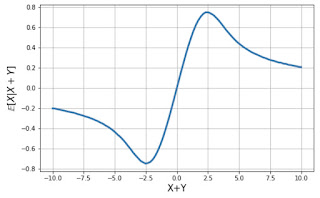Victor Chernozhukov posed the following question on twitter a few days ago: "Suppose that X~ N(0,1), and Y ~ Cauchy, X and Y are independent. What is E[X | X+Y]?"
Thien An replied "isn't it the mean of the density proportional to exp(-x^2/2)/[1+(z-x)^2]?" and she included this nice plot
illustrating the behavior of E(X | X+Y).
This recalled some rather ancient suggestions by Jim Berger about the utility of Cauchy priors.Reformulating Victor's question slightly, suppose that X ~ N(t,1) and you have prior t ~ C, Thien's nice plot can be interpreted as showing the posterior mean of t as a function of X. For small values of |X| there is moderate shrinkage back to 0, and as |X| grows the posterior mean does too. However, for large values of X, this tendency is reversed and eventually very large |X| values are ignored entirely. This might seem odd, why is the data being ignored?
I like to think about this in terms of the comedian Richard Pryor's famous question: "Who are you going to believe, me, or your lying eyes*." If the observed X is far from the center of the prior distribution, you decide that it is just an aberration that is totally consistent with your prior belief that t could be quite extreme since the prior has such heavy tails, but you stick with your prior belief that it is much more likely that t is near 0.
In contrast if the prior were Gaussian, say, t ~ N(0,1), then the posterior mean is determined by linear shrinkage, so E(t|X) is midway between 0 and X, and for large |X|, we end up with a posterior mean in a place where neither the prior or likelihood have any mass.
* In this case "me" should be interpreted as your prior, and X as what you see with your lying eyes.
